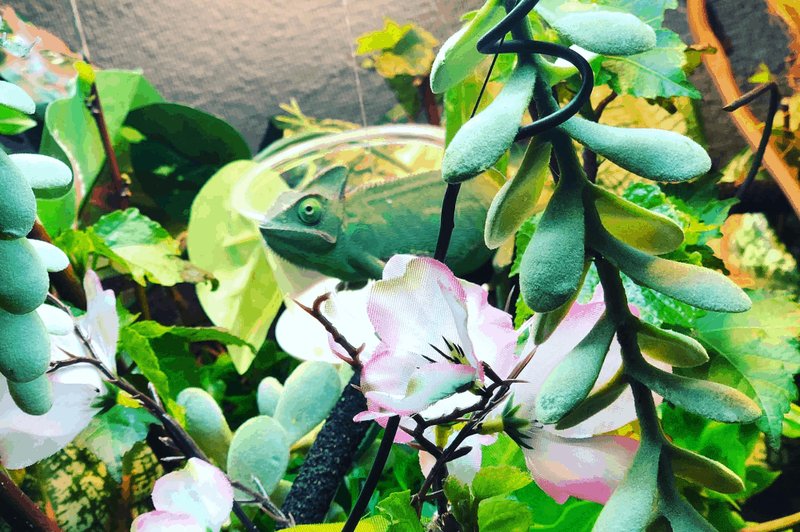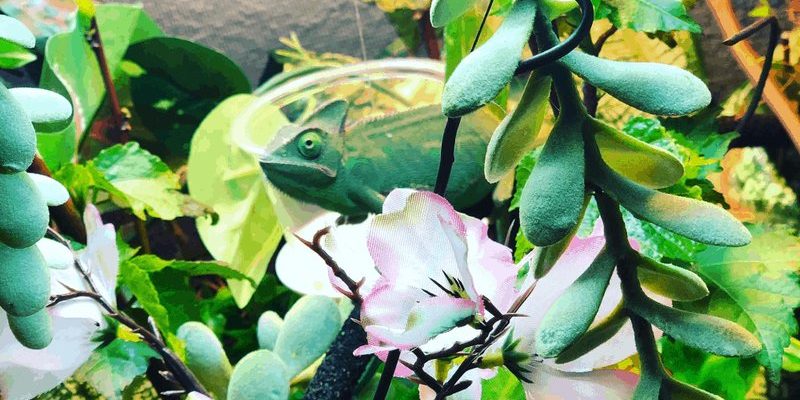
If you’re new to chameleons or just looking to improve your setup, I’m here to guide you through the best plants and décor for an Oustalet’s chameleon habitat. You might be wondering: why do plants and decorations matter so much? Well, beyond looking great, they provide essential hiding places, climbing opportunities, and even help with humidity control. So, let’s dive into what you need to create a thriving environment for your scaly friend!
Understanding the Needs of Oustalet’s Chameleons
Oustalet’s chameleons are known for their stunning colors and unique personalities. To keep them healthy, you need to consider several factors when setting up their habitat. These chameleons require plenty of vertical space, as they love to climb. A tall terrarium with proper ventilation will give them the room they need to roam.
Next, humidity is key for these creatures. They thrive in environments where humidity levels are between 50% and 70%. Plants not only add aesthetic value; they actually help maintain these moisture levels. By carefully choosing your plants and decorations, you can create an environment that mimics their natural habitat, keeping your chameleon happy and healthy.
Lastly, temperature control is important as well. Oustalet’s chameleons prefer a basking spot of around 85°F and cooler areas as low as 70°F. This means you’ll need to set up heat lamps and thermometers in your terrarium, along with the right plants that can tolerate these temperature gradients.
Best Plants for Oustalet’s Chameleon Habitats
When it comes to choosing plants for your chameleon’s habitat, you want to focus on non-toxic, sturdy plants that can withstand climbing. Here are some top picks:
- Pothos (Epipremnum aureum): This hardy plant is perfect for chameleon habitats. It’s easy to care for and can tolerate a range of conditions. Plus, its trailing vines offer excellent climbing options.
- Ficus elastica (Rubber Plant): This robust plant provides ample coverage, and its broad leaves will help increase humidity levels. It’s also low maintenance, making it a great choice for beginners.
- Spider Plant (Chlorophytum comosum): Spider plants are not only beautiful but also air-purifying. With long, arching leaves, they create a perfect natural climbing structure.
- Hoya (Wax Plant): Known for their waxy leaves and beautiful flowers, Hoyas can be a great addition. They need a bit more light but can thrive in a chameleon habitat with the right setup.
These plants are excellent at creating cover and climbing structures, allowing your chameleon to feel secure and reducing stress. Make sure to check if the specific variety you choose is safe for reptiles, as some plants can be toxic.
Décor to Enhance Your Chameleon’s Habitat
Decorating your chameleon’s habitat goes beyond just plants. Think of it as creating an adventure playground for your little friend! Here are some ideas for décor that works well:
- Branches and Vines: Natural branches and vines can create a network of climbing routes for your chameleon. Look for options like driftwood or manzanita wood, which can also add a rustic look to your setup.
- Hiding Spots: Adding places where your chameleon can hide is crucial. Decor like coconut shells or hollow logs can provide excellent hiding spots, giving your chameleon a place to retreat and feel safe.
- Reptile Hammocks: These are great for lounging! A hammock made of soft material can be hung at different heights, offering a cozy spot for your chameleon to rest.
- Water Features: A small water dish or even a small waterfall can improve humidity and provide a source of drinking water. Just be sure it’s shallow enough to prevent drowning.
Remember, while it’s important to make it visually appealing, practicality is key. Avoid sharp edges and potential hazards in your habitat.
Maintaining the Right Humidity
Humidity levels can fluctuate in a terrarium, so regular monitoring is a must. Here’s how to keep things just right:
1. Choose the right plants: As we discussed, many plants will help naturally maintain humidity.
2. Misting: Regular misting helps maintain moisture in the air. You can use a simple spray bottle or invest in an automatic misting system.
3. Use a hygrometer: This handy tool will help you keep an eye on humidity levels. Ideally, you want to aim for 50% to 70% humidity.
Here’s the thing: Too little humidity can lead to shedding problems, while too much can promote mold growth. Regular maintenance and checks will help keep everything balanced.
Lighting Considerations for Your Chameleon
The right lighting is another key component of creating an ideal habitat. Oustalet’s chameleons need both UVB and basking light. Here’s a breakdown on how to proceed:
– UVB Lighting: This mimics natural sunlight and is essential for your chameleon’s health. It helps them synthesize vitamin D3, which is crucial for calcium absorption.
– Basking Bulb: A heat lamp should provide a warm basking spot. Position it at one end of the terrarium to create a temperature gradient.
Make sure to replace bulbs every 6-12 months, as their effectiveness diminishes over time. Place the lights at a safe distance to prevent overheating your chameleon.
Creating a Balanced Environment
Creating a balanced ecosystem is all about combining the right elements. Along with plants and décor, consider other factors like:
– Ventilation: Good airflow will prevent mold and keep the environment fresh. Ensure your terrarium has proper ventilation holes.
– Temperature Zones: As mentioned earlier, create distinct temperature zones by using heat lamps and cooler corners.
– Feeding Stations: Consider where you’ll place food and water dishes. Make sure they’re easily accessible but not in spots where your chameleon can easily topple them.
When everything is in harmony, your Oustalet’s chameleon will thrive in its little jungle paradise!
Setting up an Oustalet’s chameleon habitat can be a rewarding experience when you choose the right plants and décor. By focusing on their natural needs and creating a safe, stimulating environment, you’ll provide your chameleon with the best possible home. Remember to keep humidity in check, offer climbing opportunities, and incorporate items that mimic their native habitat.
With a little bit of care and creativity, your chameleon will not only survive but flourish, becoming a vibrant part of your home. Enjoy your journey in creating an amazing habitat that both you and your chameleon will love!

